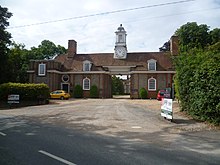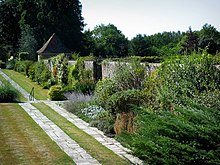
Great Maytham Hall, near Rolvenden, Kent, England, is a Grade II* listed country house. [1] The gardens are famous for providing the inspiration for The Secret Garden by Frances Hodgson Burnett.

Great Maytham Hall, near Rolvenden, Kent, England, is a Grade II* listed country house. [1] The gardens are famous for providing the inspiration for The Secret Garden by Frances Hodgson Burnett.

The original name of the Manor here was Great Maytham. In 1721 James Monypenny built a house here which he called Maytham Hall. This was completed by his son Robert Monypenny in 1760 but was largely burned down in 1893. This house consisted of a main block of two storeys and basement and two pavilions containing the laundry and stables. These 18th-century wings largely survive, but the main building was rebuilt two storeys higher by Sir Edwin Lutyens in 1909–12 for The Right Honourable H. J. Tennant, a prominent Liberal Member of Parliament, who reverted to the use of the original name, Great Maytham.
The house briefly became the home of the Royal Normal College for the Blind after the college was advised to move from its London site at the outbreak of World War II. [2] However, because of the threat of a German invasion, the authorities soon advised another move, and this time, with 24 hours' notice and the help of the London Society for the Blind, a temporary home was found for the college in Dorton, near Aylesbury, Buckinghamshire. [2] [3] The college's London campus was bombed during the Blitz and it is now located in Hereford. [3]
The house and grounds fell into decline before World War II. In 1961 [4] Great Maytham Hall was purchased and restored by the Mutual Households Association, later the Country Houses Association, a charity dedicated to saving and preserving historic stately home buildings by repurposing them from single household use. The house was converted into fifteen self-contained flats, with residents sharing reception rooms, entrance hall and drawing room; its first residents then set about restoring the gardens and grounds. In December 2003 the Country Houses Association announced that it was closing down its residential business and selling the eight Grade I and II listed buildings it still owned. [5]

The walled garden of Great Maytham Hall provided the inspiration for one of the most famous of all books for children, The Secret Garden . Its author, Frances Hodgson Burnett, lived at Great Maytham Hall from 1898 to 1907, where she found the old walled garden dating from 1721 overgrown and neglected. [6] By her own account, aided by a robin, Burnett discovered the door hidden amongst the ivy, and began the restoration of the garden, which she planted with hundreds of roses. She set up a table and chair in the garden's gazebo, and wrote a number of books there, reportedly inspired by its peace and tranquility.
When Lutyens rebuilt Great Maytham Hall he retained the old walled garden as an adjunct to the grand new brick house in the manner of Sir Christopher Wren, but landscaped the terraced lawns and surrounding parkland in his signature style, in partnership with Gertrude Jekyll, who planted his design. The gardens and grounds were managed by the Tennant family until the outbreak of the Second World War, when the estate was requisitioned by the British army. As part of the "Dig for Victory" campaign, Frances Hodgson Burnett's roses were replaced with cabbages and leeks, and the manicured lawns were patriotically planted with potatoes and carrots. A jettisoned German bomb in the middle of the former lawn did not help to improve matters, and after the war the house stood empty for many years, and the gardens were left to decline.

Frances Eliza Hodgson Burnett was a British-American novelist and playwright. She is best known for the three children's novels Little Lord Fauntleroy, A Little Princess (1905), and The Secret Garden (1911).

Castle Drogo is a country house and mixed-revivalist castle near Drewsteignton, Devon, England. Constructed between 1911 and 1930, it was the last castle to be built in England. The client was Julius Drewe, the hugely successful founder of the Home and Colonial Stores. Drewe chose the site in the belief that it formed part of the lands of his supposed medieval ancestor, Drogo de Teigne. The architect he chose to realise his dream was Edwin Lutyens, then at the height of his career. Lutyens lamented Drewe's determination to have a castle but nevertheless produced one of his finest buildings. The architectural critic Christopher Hussey described the result: "The ultimate justification of Drogo is that it does not pretend to be a castle. It is a castle, as a castle is built, of granite, on a mountain, in the twentieth century".

Winfield House is an English townhouse in Regent's Park, central London and the official residence of the United States Ambassador to the United Kingdom. The grounds are 12 acres (4.9 ha), the largest private garden in London save for that of Buckingham Palace.

Harold John Tennant PC, often known as Jack Tennant, was a Scottish Liberal politician. He served as Secretary for Scotland under his brother-in-law H. H. Asquith between July and December 1916.

Rolvenden is a village and civil parish in the Ashford District of Kent, England. The village is centred on the A28 Ashford to Hastings road, 5 miles (8.0 km) south-west of Tenterden.

Rolvenden Layne is a hamlet within the civil parish of Rolvenden in the Ashford District of Kent, England. It is located approximately one mile (1.6 km) south of Rolvenden, with a public house, the Ewe & Lamb.
Detmar Jellings Blow was a British architect of the early 20th century, who designed principally in the arts and crafts style. His clients belonged chiefly to the British aristocracy, and later he became estates manager to the Duke of Westminster.

Margaret Edith (May) Tennant, CH, née Abraham, born in Rathgar, County Dublin, Ireland, was a civil servant, trade unionist, factory inspector, and campaigner, who worked to improve conditions for industrial workers and was also involved in women's health and education. She was one of the first people to be appointed to the Order of the Companions of Honour in 1917.

Munstead Wood is a Grade I listed house and garden in Munstead Heath, Busbridge, on the boundary of the town of Godalming in Surrey, England, 1 mile (1.6 km) south-east of the town centre. The garden was created by garden designer Gertrude Jekyll, and became widely known through her books and prolific articles in magazines such as Country Life. The Arts and Crafts style house, in which Jekyll lived from 1897 to 1932, was designed by architect Edwin Lutyens to complement the garden.

Heathcote is a Neoclassical-style villa in Ilkley, West Yorkshire, England. Designed by architect Edwin Lutyens, it was his first comprehensive use of that style, making it the precursor of his later public buildings in Edwardian Baroque style and those of New Delhi. It was completed in 1908.
The Shuttle is a 1907 novel by Frances Hodgson Burnett. One of Burnett's longer and more complicated books for adults, it deals with themes of intermarriages between wealthy American heiresses and impoverished British nobles.

Marshcourt, also spelled Marsh Court, is an Arts and Crafts style country house in Marsh Court, near Stockbridge, Hampshire, England. It is constructed from quarried chalk. Designed and built by architect Edwin Lutyens between 1901 and 1905, it is a Grade I listed building. The gardens, designed by Lutyens and Gertrude Jekyll, are Grade II* listed in the National Register of Historic Parks and Gardens.
There are 20 Grade I listed war memorials in England, out of over 3,000 listed war memorials. In the United Kingdom, a listed building is a building or structure of special historical or architectural importance; listing offers the building legal protection against demolition or modification, which requires permission from the local planning authority. Listed buildings are divided into three categories—grade I, grade II*, and grade II—which reflect the relative significance of the structure and may be a factor in planning decisions. Grade II accounts for 92% of listed buildings, while grade II* is an intermediate grade accounting for 5.5%; grade I holds the remaining 2.5% of listed buildings and is reserved for structures of exceptional significance. Grade I listed war memorials are deliberately very few, though several have been upgraded to grade I status as part of commemorations around the First World War centenary. A war memorial listed at grade I will be of exceptional interest for its design and artistic merit and will be of great historical interest. Such memorials are often the work of famous architects or sculptors, amongst the most prolific of whom was Sir Edwin Lutyens, whose memorials account for a third of all those listed at grade I. Lutyens designed dozens of war memorials across the United Kingdom and elsewhere in the Commonwealth, including the Cenotaph in London—the focus for the national Remembrance Sunday services—and the Arch of Remembrance in Leicester—the largest of Lutyens' war memorials in Britain; both are listed at grade I. As part of the commemorations of the centenary of the First World War, Historic England—the government body responsible for listing in England—is running a project with the aim of significantly increasing the number of war memorials on the National Heritage List for England.

Mells War Memorial is a First World War memorial by Sir Edwin Lutyens in the village of Mells in the Mendip Hills of Somerset, south-western England. Unveiled in 1921, the memorial is one of multiple buildings and structures Lutyens designed in Mells. His friendship with two prominent families in the area, the Horners and the Asquiths, led to a series of commissions; among his other works in the village are memorials to two sons—one from each family—killed in the war. Lutyens toured the village with local dignitaries in search of a suitable site for the war memorial, after which he was prompted to remark "all their young men were killed".

Holy Island War Memorial, or Lindisfarne War Memorial, is a First World War memorial on the tidal island of Lindisfarne off the coast of Northumberland in the far north east of England. Designed by Sir Edwin Lutyens, the memorial is a grade II* listed building.

Busbridge War Memorial is a First World War memorial in the churchyard of St John's Church in village of Busbridge in Surrey, south-eastern England. Designed by Sir Edwin Lutyens, it is Grade II* listed.

Nashdom, also known as Nashdom Abbey, is a former country house and former Anglican Benedictine abbey in Burnham, Buckinghamshire, England. Designed in Neo-Georgian style by architect Edwin Lutyens, it is a Grade II* listed building. It was converted into apartments in 1997. The gardens are Grade II listed in the National Register of Historic Parks and Gardens.

Hartburn War Memorial is a First World War Memorial in the village of Hartburn, Northumberland, in the north-east of England. The memorial, designed by Sir Edwin Lutyens, was unveiled in 1921 and is today a grade II listed building.

Rolvenden War Memorial is a First World War memorial in the village of Rolvenden, Kent, in south-eastern England. Designed by Sir Edwin Lutyens, the memorial was unveiled in 1922 and is today a grade II listed building.

Hole Park is a privately owned country house near the village of Rolvenden, in Kent, England. It is a Grade II listed building. The gardens, first opened in the 1920s, are regularly open to the public.